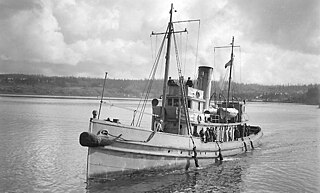USS Sacagawea may refer to the following ships of the United States Navy:

The United States Navy (USN) is the naval warfare service branch of the United States Armed Forces and one of the seven uniformed services of the United States. It is the largest and most capable navy in the world and it has been estimated that in terms of tonnage of its active battle fleet alone, it is larger than the next 13 navies combined, which includes 11 U.S. allies or partner nations. with the highest combined battle fleet tonnage and the world's largest aircraft carrier fleet, with eleven in service, and two new carriers under construction. With 319,421 personnel on active duty and 99,616 in the Ready Reserve, the Navy is the third largest of the service branches. It has 282 deployable combat vessels and more than 3,700 operational aircraft as of March 2018, making it the second-largest air force in the world, after the United States Air Force.
- USS Sacagawea (YT-241), was a tugboat, launched in 1942; acceptance by the Navy was canceled in 1942, but she was retained by the Maritime Commission.
- USS Sacagawea (YT-326), was a tugboat, acquired by the Navy and renamed in 1942, and struck in 1945.
- USNS Sacagawea (T-AKE-2) is a Lewis and Clark-class dry cargo ship, launched in 2006 and in active service

A tugboat is a type of vessel that maneuvers other vessels by pushing or pulling them either by direct contact or by means of a tow line. Tugs typically move vessels that either are restricted in their ability to maneuver on their own, such as ships in a crowded harbor or a narrow canal, or those that cannot move by themselves, such as barges, disabled ships, log rafts, or oil platforms. Tugboats are powerful for their size and strongly built, and some are ocean-going. Some tugboats serve as icebreakers or salvage boats. Early tugboats had steam engines, but today most have diesel engines. Many tugboats have firefighting monitors, allowing them to assist in firefighting, especially in harbors.
USS Sacagawea (YT/YTM-326) was built in 1925, and acquired by the United States Navy from Brazil in 1942 as Almirante No-ronka. She is one of the few US Naval vessels named for a woman. Sacagawea was a guide for the Lewis and Clark Expedition.

USNS Sacagawea (T-AKE-2), a Lewis and Clark-class dry cargo ship, is the third ship operated by the United States Navy to be named for Sacagawea, the Shoshone woman who acted as guide and interpreter for the Lewis and Clark Expedition, and one of the few United States Navy ships named for women.
| This article includes a list of ships with the same or similar names. If an internal link for a specific ship led you here, you may wish to change the link to point directly to the intended ship article, if one exists. |






